Breaking News
Taliban Seek Russian Air Defense Systems: A Risky Scenario for Civil Aviation.
As relations between the Taliban regime and Russia continue to improve, the Taliban have expressed their intention to strengthen Afghanistan's air defenses using Russian equipment, according to Forbes. While Moscow has shown a willingness to arm groups like the Houthis in Yemen and Hezbollah in Lebanon with advanced missiles, it is unclear if Russia will be as willing to extend similar support to the current regime in Kabul.
Follow Army Recognition on Google News at this link

This request, which would have seemed unthinkable a few years ago, comes at a time of warming relations, highlighted by the Taliban’s invitation to the St. Petersburg forum in May (Picture source: Vitaly Kuzmin)
In 2023, less than two years after retaking Afghanistan following the chaotic U.S. withdrawal, the Taliban allocated the largest share of their national budget to defense, signaling their intent to develop air defense capabilities. In April of that year, Qari Fasihuddin Fitrat, a Taliban commander and army chief of staff, stated that "anti-aircraft missiles are a necessity for all countries," emphasizing that Afghanistan was doing its best to acquire such systems. However, he did not specify how the Taliban planned to obtain these weapons.
This desire for air defenses became more explicit during a recent interview with Russia's state-run Tass news agency on August 29, when General Sayed Abdul Basir Saberi, head of the logistics department for the Taliban-controlled Ministry of Defense, stated that Afghanistan intended to purchase Russian-made air defense equipment. He expressed the Taliban’s interest in acquiring advanced systems from Russia when international conditions permit, noting that Russia is, in his view, the most advanced country in air defense technology.
This request, which would have seemed unthinkable a few years ago, comes at a time of warming relations, highlighted by the Taliban’s invitation to the St. Petersburg forum in May. Saberi’s comments suggest the Taliban hope these growing ties could lead to weapons acquisitions. Russia has also recently demonstrated its willingness to provide advanced weaponry to non-state actors, such as arming the Houthis with anti-ship missiles and reportedly transferring a Pantsir-S1 air defense system to Hezbollah via Syria.
Any delivery of Pantsir systems, or short- to medium-range systems like the Buk and Tor, to the Taliban would likely raise concerns in the United States. Since the U.S. withdrawal from Afghanistan in August 2021, American forces have conducted "over-the-horizon" drone strikes on Afghan targets, including the elimination of Al-Qaeda leader Ayman al-Zawahiri in Kabul. The deployment of air defenses in Afghanistan could complicate such operations. In March 2024, the Taliban claimed that U.S. drones were patrolling and "violating" Afghan airspace.

Any delivery of Pantsir systems, or short- to medium-range systems like the Buk and Tor, to the Taliban would likely raise concerns in the United States (Picture source: Vitaly Kuzmin)
The Pantsir-S1, first produced in 2008, is a short- to medium-range anti-aircraft system developed by Russia. It entered service in 2012 and has been exported to several countries. Over 200 units are currently in service in Russia. The system combines radar-guided surface-to-air missiles with dual 30mm automatic cannons, providing mobile defense against aircraft, helicopters, drones, and precision-guided munitions, with a range of up to 20 km.
The Buk missile system, first developed in the 1970s, has seen modern versions such as the Buk-M2 and Buk-M3 enter production in 2008 and 2016, respectively. The Buk-M2 entered Russian service in 2008, followed by the Buk-M3 in 2016. Several hundred of these systems are in service in Russia and abroad. Designed for medium-range engagements, the Buk-M2 and M3 can intercept aircraft, cruise missiles, and ballistic missiles at ranges of up to 70 km (M2) and 100 km (M3), providing robust defense against a variety of aerial threats.
The Tor-M2 is a short-range air defense system that began production in the late 1980s, with the improved Tor-M2 variant entering production in 2008. It entered service with Russia in 2012, with several hundred units currently in operation, both in Russia and internationally. The Tor-M2 can intercept aircraft, helicopters, drones, and missiles at a range of up to 12 km, offering rapid and mobile protection for ground forces.
On the same day as Saberi’s interview, Iraqi forces shot down a Turkish Aksungur drone over Kirkuk, reportedly using a Pantsir-S1 system. Such incidents raise concerns that any air defense systems supplied by Russia to the Taliban could also pose a risk to civil aviation. Afghan airspace has become a major corridor for flights between Europe and Asia, and a growing number of commercial flights now transit through the region. The risk of a tragic accident, such as the accidental downing of a civilian aircraft, cannot be ruled out. In January 2020, Iran mistakenly shot down a Ukrainian airliner near Tehran using a Russian Tor missile during heightened tensions with the United States.

With the departure of the Americans and their takeover, the Taliban gained access to numerous military equipment. (Picture source: Taliban Army)
Despite these concerns, some analysts doubt that Russia is prepared to supply sophisticated weaponry to the Taliban in the near future. Pavel Luzin, a non-resident fellow with the Democratic Resilience Program at the Center for European Policy Analysis, described Saberi’s comments as “sweet talk” aimed at the Kremlin. While the Taliban may want advanced air defense systems, Luzin argues that they are not yet ready to acquire them.
He further noted that Russia, although historically willing to supply weapons free of charge to various global actors, is currently unable to export sophisticated air defense systems like the Pantsir or Tor due to the losses sustained in the Ukraine conflict, which has significantly weakened Russia’s military capacity.
Moreover, any air defense deal would require more than just equipment delivery; it would also necessitate training operators. The Taliban lack the technical expertise to operate such complex systems. Therefore, the presence of Buk or Pantsir systems in Afghanistan would likely mean that Russian military personnel were operating them, making any cooperation between Russia and the Taliban on air defense particularly complicated.
The relationship between Russia and Afghanistan, particularly with the Taliban, has been marked by a complex history. During the Soviet invasion of Afghanistan in the 1980s, the Taliban, then emerging from the ranks of the mujahideen, fought Soviet forces with support from the West, particularly the United States. After the Soviet withdrawal and the fall of the Moscow-backed government in 1992, Russia viewed the Taliban as a threat, especially due to their links to extremist groups in the Caucasus. However, since the Taliban took power in 2021, Russia has adopted a more pragmatic approach, maintaining diplomatic contacts with the group in an effort to stabilize the region and contain extremism.


























